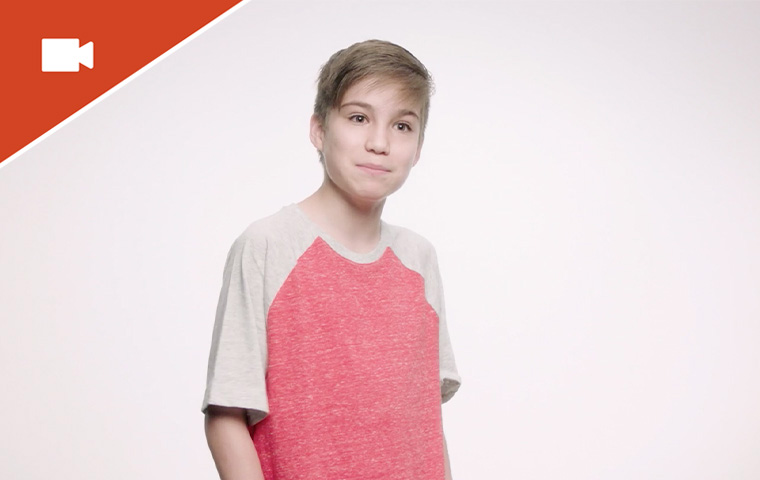Teens Behind the Wheel
Your teen just got his (or her) driver’s license, a milestone that is both exciting and scary. The good news is that he’ll develop his sense of independence—and you’ll probably appreciate not having to drive him all over town anymore. The scary part is making sure he stays safe while behind the wheel. You can help protect him and others on the road by making sure he knows and follows the laws and rules that come with this new privilege.
Remind your new driver of four things he must always do:
-
Before you even put the car in gear make sure everyone is wearing a seat belt—front seat and back
-
Let only one passenger ride with you.
-
Put away your phone before starting the car. No exceptions.
-
Never drive after drinking alcohol or taking any drug that affects your reflexes or judgment. Arrange for a safe ride instead.
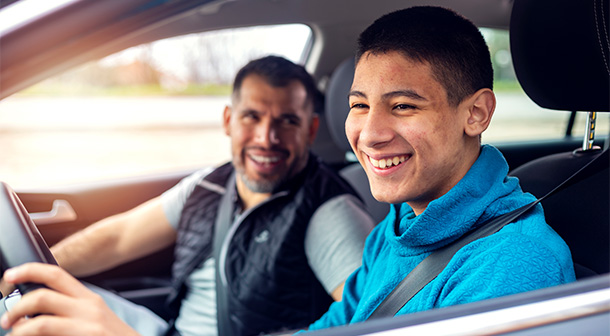
The riskiest teen driving behaviors are speeding, distracted or drowsy driving, and not buckling up. (National Transportation Safety Board)
Parent-Teen Driving Agreement
Help your teen be a safe driver by creating a parent-teen driving agreement. Do it before he ever starts driving—here’s an example parent-teen driving agreement you can use. Your agreement should cover the rules he must follow and what the consequences will be if he doesn’t. For example, texting or talking on the phone while driving could mean giving up the car keys or his phone for a set period of time. Talk to your teen about the rules up front and make clear what will happen if he breaks them. Remind him that these rules are for his own safety and the safety of others. Finally, be sure to enforce the rules consistently.
8 Danger Zones of Teen Driving
Many teen drivers make mistakes they could have avoided. Get familiar with the following risks so you can help manage them:
1. Driver Inexperience
New drivers are the most likely to experience crashes and injuries. The risk for teen drivers is highest during their first year of driving. A great way to give your teen more experience and confidence is to sign him up for a certified driver’s education course. Then, practice, practice, practice. Ride with your teen on all kinds of drives—on different roadways, at different speeds, during the day and at night, in light traffic and heavy traffic—for several weeks or months.
Be sure to remind him to:
- Pay attention to all signs, including ones in construction and school zones.
- Look for speed limits and obey them.
- Keep an eye out for pedestrians, motorcycles, bicycles, animals, and any hazards such as road damage or debris.
- Use the rear view and side mirrors regularly.
- Always yield to emergency vehicles.
Teens also need positive feedback. Make sure to recognize good driving with kind words and possibly a reward, like a trip to his favorite drive-thru restaurant. Reinforcing safe and considerate driving will help him build good habits. And remember to model those same behaviors when you’re driving!
You may feel anxious when you first start riding with your teen driver but be sure to let him know you believe in him and that you’re proud he’s taking this big step.
2. Driving with Teen Passengers
Two’s company, three’s a crowd. Peer pressure is strong in the teen years, and it can lead to dangerous distractions when it comes to driving. You can protect your teen driver by limiting the number of passengers he’s allowed to have in his car.
Texas law limits the number of passengers for teen drivers to family members plus one other person (age 20 and younger) for six months after they get their license. The Graduated Driver License (GDL) has restrictions that give new drivers time to improve their driving skills in lower-risk environments, including driving without the distraction of other teens. Other limits include no use of electronic devices, and no driving between midnight and 5 a.m., with some exceptions.
If your teen is planning to get together with lots of friends, make sure you do the driving until the GDL program has ended.

3. Nighttime Driving
Fatal crashes are more likely to occur at night. Experienced drivers understand that night driving takes extra attention and skill—two traits teen drivers need time to develop. The Texas GDL law restricts teens 17 years and younger from driving between midnight and 5 a.m. However, you should also set and enforce driving curfews that work for your family.
4. Seat Belt Use
Seat belts save lives, yet studies show that teens and young adults are the least likely to use them. Seat belts are the best defense against motor vehicle injuries and fatalities because they protect against extreme forces that happen in an accident. However, in 2019, 43.1% of U.S. high school students did not always wear a seat belt when riding in a car someone else was driving.
Teen drivers should always buckle up behind the wheel, and they should also make sure all passengers fasten their seat belts before starting their trip. Wearing a seat belt isn’t just safer, it’s also required by law in Texas. All vehicle passengers are required to use seat belts. Drivers can be fined up to $200 in fees and court costs. Talk with your teen about how it may not be easy for him to tell his friends to buckle up. Try practicing the scenario with him and be sure to include the seat belt rule in your parent-teen driving agreement.
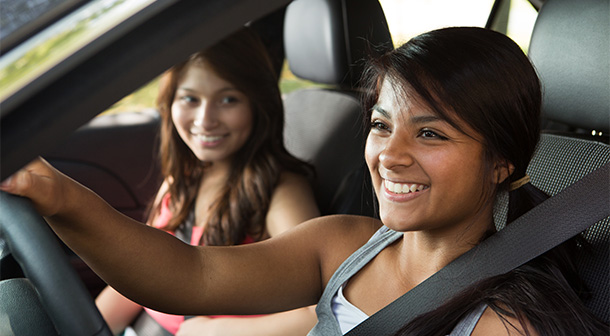
5. Distracted Driving
Phones, food, friends—all of those take any driver’s mind off the road. But the risk of an accident is higher for teens because they’re much less experienced drivers.
The definition of distracted driving is doing anything that takes your attention off the road. The three main types of distractions are:
- Visual: taking your eyes off the road. This can be checking a phone or GPS, changing the radio station, or looking at a passenger.
- Manual: taking your hands off the wheel. Examples include drinking, eating, dialing or typing, and reaching for something in another seat.
- Cognitive: taking your mind off driving. Daydreaming and talking on the phone take your focus off the task at hand: paying attention to the road.
Using a cell phone combines all three distractions. Work with your teen to come up with a plan for stashing his phone while driving so he cannot use it. Check out cell phone blocking apps that automatically prevent him from using the phone to talk, text, or access the internet while driving. And remember to model good phone behavior when you drive. Your teen is paying attention!

6. Drowsy Driving
Teens who drive early in the morning or late in the day may be sleepy and inattentive, which increases their risk for a crash. The National Sleep Foundation (NSF) recommends that teens get 8 to 10 hours of sleep per night, but school, work, and social schedules often prevent that. The NSF notes that sleep deprivation is common among teens, and 55% of drowsy-driving crashes involve people under the age of 25.
Drowsy driving can be as dangerous as driving while under the influence of alcohol or drugs (source: NSF). Work with your teen to create a plan to avoid drowsy driving. You can make drowsy driving part of your parent-teen driving agreement so he knows what to do if he’s too sleepy to drive safely.
You can also help by monitoring your teen’s schedule and sleep needs, helping him get enough rest. A rested teen will do better behind the wheel and at school.
7. Reckless Driving
Teen drivers often speed and drive too close to the car in front of them, which are both examples of reckless driving.
A teen’s brain hasn’t developed fully yet in the areas of decision-making, judgment, and impulse control. Also, teens may not think ahead about the consequences of reckless driving.
You can enforce driving speeds through your teen-parent driving agreement and by using safety technology to govern speed (see Safety Technology, below). Practice driving in different conditions—heavy traffic, complicated roadways—to get your teen used to driving in situations that may be stressful or likely to cause him to make rash decisions.
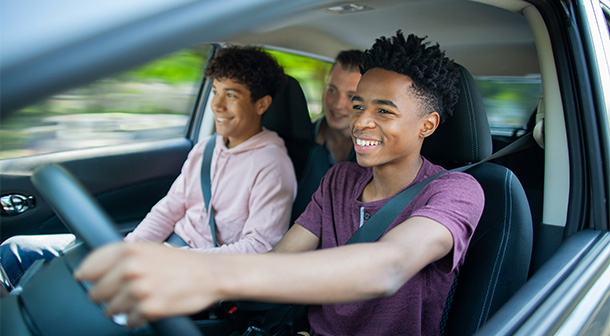
8. Impaired Driving
Don’t drink and drive. We have all heard that saying. Yet in 2019, 24% of drivers between the ages of 15 and 20 who died in car crashes had been drinking (CDC). Teens need to learn early about the severe consequences of drinking and driving. People who drink and drive endanger themselves, their passengers, and others on the road. They also break the law and risk being arrested, having their license suspended, and being fined and charged court costs. In Texas, anyone under the of age 21 is breaking the law if they have any detectable amount of alcohol in their system while driving on a public street.
Help your teen avoid the dangers of impaired driving by stressing that he doesn’t use alcohol or drugs, he never gets in a car with a driver who has been drinking or used drugs, and that he knows how to get a safe ride if he needs one. Repeat these rules often to help reinforce how serious impaired driving is.
Safety Technology
Technology has come a long way, and that’s good news for parents. In-vehicle technologies can help keep teen drivers safe on the road. Some helpful features are listed below.
- Speed limit recognition warns drivers when they’re speeding.
- Adaptive cruise control adjusts a vehicle’s speed to keep a safe distance from the rear of another one.
- Automatic emergency braking activates when necessary.
- Lane-keeping assistance beeps to alert drivers when they stray from their lane.
If you don’t have a car with these features, you can use smartphone apps to access safety technology. Apps are a great way to stay informed on how your teen is driving. Check with your car insurance company to see whether they have an app that monitors driving behavior. In some cases, they may offer a discount for app usage.
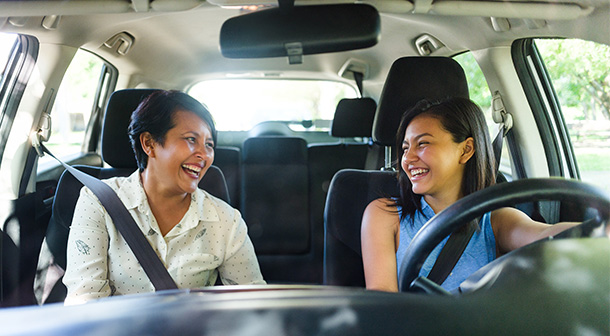
Help Your Teen Be Prepared
In addition to helping your teen handle the eight danger zones, you can also help him be prepared in case of an emergency. Consider having a car emergency kit that includes first aid, water, nonperishable snacks, a flashlight, a blanket, a small amount of cash, and other helpful items. Make sure your teen’s phone includes emergency contacts. Teach him to stay aware of weather conditions and how they may change. If possible, practice driving in rain, fog, and other potentially dangerous conditions. Remind him to never drive his vehicle into high water.
Enjoy the Ride
Teens get the privilege and responsibility of driving at a young age, and that’s why rules and laws are so important to follow. Before he heads out on the road, make sure your teen always covers the checklist below to help keep him safe and give you peace of mind.
- Turn on the phone blocking app or device or store the phone in the glovebox or trunk (whichever you have agreed upon).
- Make sure everyone in the vehicle is buckled up
- Turn down the music volume or turn it off (whichever you have agreed upon).
- Look in the rear view and side mirrors, adjust them if necessary, and scan 360 degrees around before moving the vehicle.
Congratulations to you and your teen as you begin this new adventure! Education, responsibility, and lots of practice will pay off in years of safe and enjoyable time on the road.


